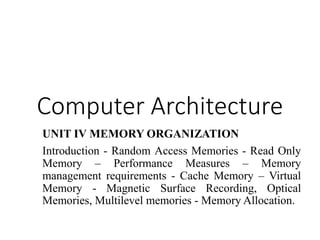
Unit- 4 Computer Oganization and Architecture
- 1. Computer Architecture UNIT IV MEMORY ORGANIZATION Introduction - Random Access Memories - Read Only Memory – Performance Measures – Memory management requirements - Cache Memory – Virtual Memory - Magnetic Surface Recording, Optical Memories, Multilevel memories - Memory Allocation.
- 2. • Basic concepts of memory system - Introduction • Computer memory, • should have a large, • facilitate execution of programs with huge amounts of data. • should be fast, large, and inexpensive. • but it is impossible to meet all three requirements. • The maximum size of the memory, • determined by the addressing scheme. • For example, a 16-bit computer that generates 16-bit addresses • addressing up to 216 = 64K (65536) memory locations. • 32-bit addresses contains up to 232=4G (giga) memory locations • The number of locations represents the size of the address space.
- 3. • From the system point, • memory unit as a black box. • Data transfer through the use of two processor registers, • (MAR and MDR). • If MAR is k bits long and MDR is n bits long, then the memory unit may contain up to 2k addressable locations. • During a memory cycle, n bits of data are transferred. • the processor bus has k address lines and n data lines. • The bus also includes the control lines, Figure. • Figure Connection of the memory to the processor
- 4. • The processor reads data by loading the address into the MAR, • setting the R / W line to 1. • The memory responds with data onto the data lines, • by asserting the MFC signal. • loads the data into the MDR register. • The processor writes data by loading the address into MAR and the data into MDR. • setting the R/ W line to 0.
- 5. • The time between the Read and the MFC signals is referred to as the memory access time. • If any location can be accessed for a Read or Write operation some fixed amount of time that is independent of the location's address in a memory unit • random-access memory (RAM). • cache memory - to reduce the memory access time, small & fast. • inserted between the larger, slower main memory and processor. • Virtual memory, increase the size of the physical memory. • Data are addressed in a virtual address space. • active space is mapped onto locations in the physical memory.
- 6. • Random Access Memory • Semiconductor memories are available in a wide range of speeds. • Their cycle times range from l00ns to less than 10 ns.
- 7. • Random Access Memory • row of cells - a memory word, and • cells of a row are connected to a common line • referred to as the word line, • driven by the address decoder on the chip. • Sense/Write circuit, • cells in each column are connected • data input/output lines of the chip are connected. • during a Read, circuit transmit the information to the output data lines. • During a Write, the circuit receive input and store it in the cells.
- 8. • Types of RAM
- 9. • STATIC MEMORIES – Static RAM • circuits retain their state as long as power is applied. • two inverters are cross-connected to form a latch. • latch is connected to two bit lines by transistors Tl and T2. • These transistors act as switches. • the cell is in state 1 if the logic value at X is 1 and Y is 0. • Read operation • If the cell is in state 1, the signal on bit line b is high and the signal on bit line b' is low. • The opposite is true if the cell is in state 0. • Write operation • if Tl and T2 are turned on (closed), it lines b and b' will have high and low signals, respectively.
- 10. • Dynamic RAM • Static RAMs are fast, high cost because of several transistors. • So simpler cells - dynamic RAMs (DRAMs). • Information or charge, maintained for only tens of milliseconds. • cell consists of a capacitor, C, and a transistor, T. • to store information, transistor T is turned on.
- 11. • Types of DRAMs • RAS - Row Address Strobe • CAS - Column Address Strobe
- 12. • Asynchronous DRAM • A 16-megabit DRAM chip, configured as 2M x 8. • The cells are organized in a 4 K x 4 K array. • The 4096 cells in each row are divided into 512 groups of 8 data. • During a Read or a Write operation, the row address is applied under the control of Row Address Strobe (RAS) input of the chip.
- 13. • After the row address is loaded, the column address is loaded into the column address latch under control of the Column Address Strobe (CAS) signal. • The information is decoded and the appropriate group of 8 Sense/Write circuits are selected. • For a Read operation, the output values of the selected circuits are transferred to the data lines, D7-0. • For a Write operation, the information on the D7-0 lines is transferred to the selected circuits.
- 14. • Synchronous DRAM • The operation is directly synchronized with a clock signal. • The cell array is the same as in asynchronous DRAMs. • The address and data connections are buffered by registers. • The output of each sense amplifier is connected to a latch. • A Read operation causes the contents of all cells in the selected row to be loaded into these latches. • Data held in the latches that correspond to the selected column(s) are transferred into the data output register. • Modes of operation can be selected by writing control information into a mode register.